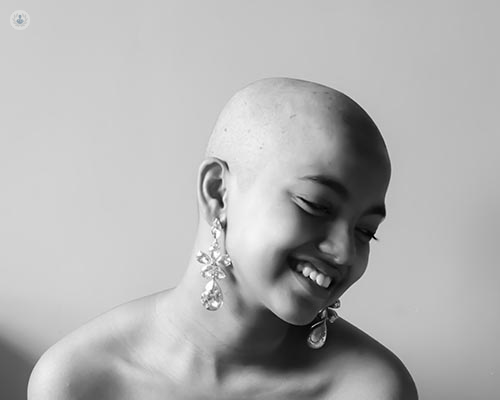Alopecia areata: causes, types and risk factors
Escrito por:Alopecia areata is a condition which produces hair loss, and can result in the person sufferer to feel embarrassed, ashamed and upset about their appearance. Esteemed dermatologist and dermatological surgeon Dr Paul Farrant explains more about the condition, including the various types and risk factors linked to the disease.

What is alopecia areata?
Alopecia areata is a common condition that usually presents with smooth bald patches in the scalp. They can also expand outwards and join up. In severe cases, it can lead to total scalp loss (alopecia totalis) or total body hair loss (alopecia universalis).
What are the common symptoms of alopecia areata?
Most patients experience localised smooth patches of total hair loss without any symptoms. Occasionally some patients might experience scalp itch preceding a new patch. There usually isn’t any redness, scale, crust, itching or pain.
What causes alopecia areata?
Alopecia areata is caused by the body’s immune cells (lymphocytes) wrongly attacking the lower portion of the hair follicle. This results in disrupted growth, or the inability of the follicle to produce a hair fibre.
Is alopecia areata an autoimmune disorder?
Alopecia is considered to be an autoimmune condition in that it is your own bodies normal immune cells (T Lymphocytes) attacking your own hair follicles.
How does alopecia areata affect hair follicles?
Once the hair follicle is attacked, it regresses in size and enters into the resting phase known as telogen. During this phase no hair fibre is produced. The hairs are only attacked when they are in the growth phase known as anagen. After a few months, the follicle will exit telogen and try to elongate and grow. If the immune system has regulated itself or has been controlled through medication. This means that Alopecia areata is a form of non-permanent hair loss that can be treated and hairs can regrow.
What are the different types of alopecia areata?
Alopecia areata typically presents with either a single patch or multiple patches. Some patterns, such as the ophiasis pattern, which describes a snake like pattern around the back of the head, can be more challenging to treat.
It is possible for alopecia to spread to involve the whole scalp or the entire body, and in some cases, alopecia will only affect the eyebrows, lashes or nails.
Can alopecia areata affect other body hair, not just scalp hair?
Yes, it is entirely possible for alopecia to affect other body hair, not just scalp hair. However, in general, this is much less common and is usually a feature of more severe disease.
Are there any risk factors associated with developing alopecia areata?
Most people with alopecia are very healthy, and it is not commonly linked with other diseases.
It is an autoimmune condition and other autoimmune conditions may co-exist, such thyroid disease. In addition, alopecia can be commonly linked to eczema, asthma and hayfever.
Is alopecia areata hereditary?
Yes, alopecia areata can be hereditary, as there are genes involved in alopecia. These can run in families and the presence of genes makes you more susceptible to developing alopecia, or other autoimmune conditions


